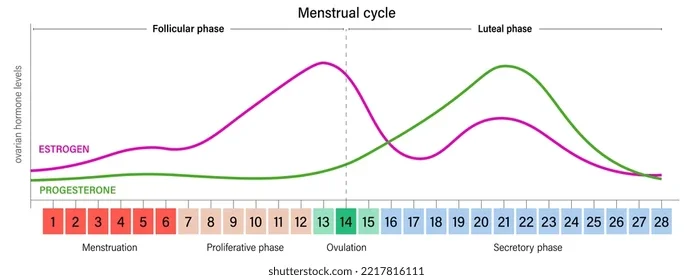Histamine Intolerance & Your Menstrual Cycle: What No One Is Talking About
This week, one of my clients taught me something incredible.
We’ve been exploring whether histamine intolerance was contributing to her ongoing symptoms. She’s very in tune with her body—and as we tracked her cycle together, she noticed something fascinating: her histamine-related symptoms eased up as she shifted out of the luteal phase and into her menstrual phase.
That observation sent me down a research rabbit hole—and what I discovered may be the missing piece for many women dealing with mysterious symptoms.
What Are Histamines, Really?
Histamine is a compound derived from the amino acid histidine. It plays a crucial role in your immune system, especially during allergic reactions. While we often villainize histamines, they’re not inherently bad. Your body was designed to use what’s useful from histamine and break down the excess through natural detoxification pathways.
You encounter histamine daily, both produced by your body and through foods such as:
Matured cheeses
Processed meats and fish
Fermented drinks (beer, wine, kombucha)
Chocolate
Yeast-containing foods (bread, beer)
Spinach, tomatoes, eggplant, pumpkin, olives
Citrus fruits
Leftovers
If you’re histamine-intolerant, eating these foods may trigger a wide range of symptoms—from itchy skin to migraines, bloating, and even PMS-like complaints.
How Your Body Breaks Down Histamine
Your body relies on two main pathways to clear histamine:
HNMT (Histamine-N-Methyltransferase) – a methylation process that deactivates histamine inside your cells.
DAO (Diamine Oxidase) – the enzyme that breaks down histamine in foods before it can cause trouble.
Most histamine intolerance issues stem from impaired DAO enzyme activity. When DAO isn’t working well, histamine builds up and symptoms appear.
Common Symptoms of Histamine Intolerance
Because histamine impacts multiple systems, symptoms can vary widely. Some of the most common include:
Skin: hives, itching, flushing, swelling, eczema
Digestive: bloating, gas, diarrhea, stomach pain, reflux, nausea
Neurological: headaches, migraines, anxiety, brain fog, insomnia
Respiratory: congestion, sneezing, postnasal drip, asthma-like symptoms
Cardiovascular: palpitations, blood pressure swings
Menstrual/Hormonal: irregular or heavy periods, breast tenderness, mood swings
Other: fatigue, temperature sensitivity, heightened reactions to fermented foods
Sound familiar?
The Hormone Connection: Why Symptoms Fluctuate
Here’s where it gets fascinating:
Emerging research (and clinical observation) suggests estrogen directly impacts DAO activity.
Estrogen can increase histamine release from mast cells.
At the same time, it can reduce DAO’s effectiveness, allowing histamine to build up.
High estrogen phases—like right before ovulation and throughout the luteal phase—often correlate with heightened histamine reactivity.
To make matters trickier, histamine itself can stimulate further estrogen production, creating a vicious cycle.
This may help explain why many women notice worsening symptoms in the second half of their cycle or during perimenopause when estrogen levels fluctuate wildly.
In fact, an older study (Fogel, 1986) noted reduced DAO activity in the liver with higher estrogen exposure, suggesting one mechanism behind these shifts.
How to take action:
If you notice histamine-related symptoms—headaches, bloating, rashes, PMS—that seem worse in the luteal phase, it may not be “all in your head.” Your hormones could be amplifying your body’s histamine response.
Practical steps you can try:
Track your symptoms alongside your menstrual cycle. Look for patterns.
Temporarily reduce histamine-rich foods during your luteal phase.
Work with a practitioner trained in functional nutrition to identify root causes and create a targeted plan. In my practice, we often use:
The GI-MAP to assess gut health and DAO enzyme activity.
The DUTCH Test to evaluate hormone fluctuations and estrogen dominance.
A comprehensive Signs & Symptoms Questionnaire that helps us connect your unique experiences with possible underlying imbalances.
Explore whether estrogen dominance (too much estrogen relative to progesterone) might be a root cause.
Support gut health, since DAO is produced in the intestinal lining.
Why This Matters
Women’s health is still vastly understudied and underfunded. The limited research available on estrogen and histamine is frustratingly thin. But that doesn’t mean we ignore the patterns women see in their own bodies.
In fact, some of the most powerful insights in functional medicine come from clinical observation—paying attention to real women, not just lab rats.
So if you’ve been struggling with symptoms that don’t seem to make sense—or that your doctor can’t explain—it may be worth asking:
👉 Could histamine intolerance and hormonal fluctuations be part of the picture?
Your body isn’t broken. It’s communicating. When we learn to listen to its shifts across the menstrual cycle—and connect the dots between hormones, nutrition, and symptoms—healing finally starts to feel possible.
If this resonates with you and you’re curious about exploring your own histamine-hormone connection, I’d love to support you. Together, we can identify the root causes and create a plan that actually works with your body.
References: Fogel W. A. (1986). Diamine oxidase (DAO) and female sex hormones. Agents and actions, 18(1-2), 44–45. https://doi.org/10.1007/BF01987978van Odijk J, Weisheit A, Arvidsson M, Miron N, Nwaru B, Ekerljung L. The Use of DAO as a Marker for Histamine Intolerance: Measurements and Determinants in a Large Random Population-Based Survey. Nutrients. 2023;15(13):2887. Published 2023 Jun 26. doi:10.3390/nu15132887Hagmeyer, R. Is estrogen causing your histamine intolerance and MCAS symptoms? DrHagmeyer.com. Published approximately 10 months ago. Accessed July 28, 2025.Brighten J. Histamine and PMDD: The Hidden Link Worsening Your Symptoms. DrBrighten.com. Published March 7, 2025. Accessed July 28, 2025


